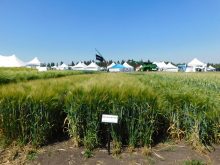The canola market saw another week of ups and downs during the period ended Aug. 3, but managed to finish on the plus side overall. U.S. weather concerns and uncertainty over the size of the canola crop itself provided underlying support.
With early harvest operations expected to pick up steam over the next few weeks, the inevitable selling off the combine has the potential to limit the nearby upside potential in canola. However, many analysts these days, and farmers for that matter, seem to be of the opinion that a retest of the highs set only a couple of weeks ago is still possible. On the bullish side for canola prices are persistent U.S. drought conditions, the solid fall export program already on the books, and ideas that the Canadian crop may not be as big as earlier expectations.
Read Also

New crop insurer policy enables easier startup for faba beans
Agriculture Financial Services Corporation updated its normals for faba beans, which may open the door for more Canadian producers to feel comfortable growing the pulse crop in the future.
Chicago (CBOT) soybeans, corn, and wheat experienced some volatility of their own during the week, as the futures reacted to the latest weather reports and outside economic news. Parts of the U.S. Midwest finally saw some much-needed rain, and the resulting profit-taking weighed on the agricultural markets at one point. However, corn is past the point of no return at this stage, while soybeans will still need more moisture in order to salvage the yields. Both commodities moved higher and the near-term focus should remain squarely on yield prospects out of the Midwest.
The U.S. Department of Agriculture was to release a key production report on Aug. 10, and pre-report analyst estimates called for sizable reductions in the crop prospects compared to earlier reports.
Oats lag other markets
The interesting development in the U.S. grain market over the past few weeks is the lacklustre performance in oats. Oats bids in Chicago were down during the week, despite the gains in corn, as the spread between the two commodities continues to widen. At the beginning of June new-crop corn futures were about US$2.25 per bushel over oats, but that spread has since widened out to over US$4.25.
Given the current situation, the downside for Canadian oats bids is virtually non-existent, with the bias to the upside as long as the spread between corn and oats is so wide. If the market finds itself in a scenario of declining U.S. corn supplies, a firmer domestic barley market and tighter feed wheat supplies, oats that would typically go to the milling market will all of a sudden be competitive in the feed market. If more oats start finding their way into feed channels, the millers would be forced to pay up to bring in supplies.
CWB 2.0, ICE struggles
Turning to the wheat markets, Minneapolis and Chicago were both mostly lower on the week, while Kansas City managed to post some small advances.
It was a historic week for the grain markets in Western Canada, as the turning of the clock on the new crop year marked the end of the Canadian Wheat Board’s long-standing single desk and the beginning of the new open market for wheat and barley. Gerry Ritz, Stephen Harper and supporters of the government’s move were out celebrating their newfound “freedom” at a barbecue in Saskatchewan, while those on the other side were vowing to appeal and dressing up in costume in downtown Winnipeg.
The newly rebranded CWB, to its credit, was diplomatic as it unveiled its new social media-inspired logo and expressed confidence in its ability to remain an effective marketer in the new reality.
Right, wrong or indifferent as far as the marketing system is concerned, the fact remains that aside from the rhetoric there should be a good-size spring wheat crop to deal with this year. Whether or not any of that wheat is priced through ICE Futures Canada, however, remains to be seen. Open interest in the Canadian contracts is very light, while the Minneapolis Grain Exchange (MGEX) is reporting record volumes and appears to be the favoured choice so far. Milling wheat futures in Winnipeg saw a grand total of three contracts trade hands during the week. Durum and barley were both untraded.
ICE Futures Canada officials remain optimistic that their exchange will eventually be the exchange of choice for pricing Canadian wheat, but that remains to be seen and will take some initiative from participants.















